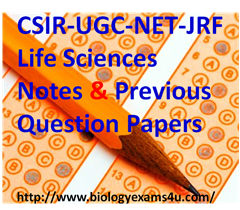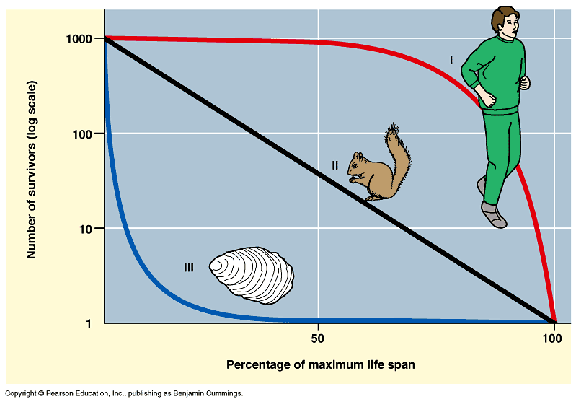
a) Temperate deciduousb) Temperate evergreenc) Taigad) Grasslands
2. Among the following which is the best indicator of water pollution due to mixing of human faeces (June 2006)
a) Parameciumb) Bacillusc) Trypanasomad) E.coli
3. Among the following which is not an characteristic feature of r-selected species (June 2006)
a) Maturity at later stageb) large clutch sizec) small size of offspringd) maturity at early stage of life
4. It has been observed the bacteria secretes toxin at high population density to check the population size. This phenomenon is termed as (June 2006)
a) Quorum sensingb) Population controlc) Alleopathyd) Interspecific competion
5. The accumulation of DDT has decreased the population of pelican ducks because DDT(June 2006)
a) Killed all duckenb) decreased availability of Ca for egg shells which leads into thin shelled fragile eggsc) Stopped synthesis of eggsd) Interfered Ca metabolism
6. Hot spots are primarily designated on basis (June 2006)
a) Endemismb) Species diversityc) Area covered speciesd) Flowering plant species
7. Phytoplankton spends very little energy on developing protective structures against predator, this suggests that why (June 2006)
a) Food chain is smallb) There is less competitionc) Productivity of aquatic ecosystem is lowd) Assimilation efficiency is high in aquatic ecosystem
8. Temporary fluctuation in population size is due to (June 2006)
a) Migrationb) Carrying capacityc) Bottle neckd) Interspecific competition
9. Stenohaline organisms can (June 2006)
a) Tolerate Narrow range of salt concentrationb)Tolerate wide range of saltc) Escapes salty conditionsd) Can secrete extra salt to keep salt amount constant
10. Effective population size for completely monogamous species having 40 males and 10 females would be (Dec 2006)
a) 42b) 32c) 20d) 10
11.Characteristic feature of K-selected species is (June, 2007)
a) High intrinsic rate of growthb) small size and large number of offspringsc) large age at first reproductiond) short life span
12. Biodiversity hot spots are characterized on the basis of (June, 2007)
a) Endemic flowering plants and threat perceptionb) Endemic flowering plantsc) Species of flowering plantsd) Treat perception
13.Which national park is not correctly matched with its organism (June, 2007)
a) Ranthambore-Bengal Tigerb) Rajaji- Hollock gibbonc) Kanchanjanga- Rhino cerosd) Bandipur -Elephant
14. Correct order for increasing order of primary productivity is (June, 2007)
a) Ocean-Desert-Tropical deciduous forest-tropical rain forestb) Desert- tropical deciduous- ocean -tropical rain forestc) Tropical rain forest- ocean- tropical deciduous-Desertsd) Tropical deciduous-Desert-ocean-Tropical rain forest
15. Type III survivorship curve is shown by (June, 2007)
a) Birdsb) Pelagic fishesc) Humansd) Phytophagous insects
Answers
1. a) Temperate deciduous
Temperate deciduous forest
- Annual temperature/Weather: 6-20 oC /warm summer, cold winters
- Annual Rainfall: 100-250 cm
- Important features: Shrubs, herbs, ferns, mosses, lichens, grasses, vines are seen.Dominant trees are oak, birch, maple, beech,magnolia,poplar,chestnut etc.
Fauna consists of of deer, fox, rabbit, hare, snakes, lizards, salamanders, owls, sparrows etc (Refer: Major Biomes of the World).
2. d) E.coli
3.a) Maturity at later stage (Refer: Difference between r-Selection and K-Selection)
4. a)Quorum sensing
Quorum sensing is the regulation of gene expression in response to fluctuations in cell-population density. Quorum sensing bacteria produce and release chemical signal molecules called autoinducers that increase in concentration as a function of cell density.
5.b) decreased availability of Ca for egg shells which leads into thin shelled fragile eggs
DDT and its relatives alter the bird's calcium metabolism in a way that results in thin eggshells. Instead of eggs, heavily DDT-infested Brown Pelicans and Bald Eagles tend to find omelets in their nests, since the eggshells are unable to support the weight of the incubating bird.
6. a) Endemism
Endemism are restricted in their distribution to a small region. This phenomenon of restricted distribution associated with some geographical or ecological factors is called endemism.
For example: Ficus religiosa, Ficus bengalensis, Saraca indica are endemic Indian plants.
many species of lemur are endemic to the island of Madagascar.
7.b) There is less competition
8 a) Bottle neck
If a population undergoes sudden reduction in its numbers may be due to environmental catastrophe or over exploitation, it is said to have gone through a bottle neck.
9 a) Tolerate Narrow range of salt concentration
Euryhaline can withstand wide ranges of salinity
10. 32 (Refer :Effective population size Calculation )
11.large age at first reproduction
12. Endemic flowering plants and threat perception
Biodiversity hotspots are characterized by rich compositions of vascular plant species and high rates of endemism.
13.b) Rajaji- Hollock gibbon
14. a) Ocean-Desert-Tropical deciduous forest-tropical rain forest
15.d) Phytophagous insects
Survivorship curve
I. Humans and other large mammals; those who fit this curve produce few offspring, but provide them with good care.
II. Ground squirrels, rodents, invertebrates, lizards, annual plants; this curve includes animals with a constant death rate.
III. Oysters; those within this survivorship curve produce many offspring, but provide little to no care for them.
Tags:
CSIR Ecology Questions
csir life science questions
ecology
Ecology Notes
ecology questions
Stenohaline
survivorship curve


